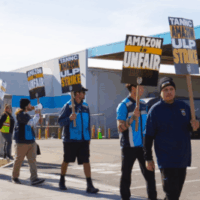Despite Rollbacks in Benefits and Eligibility, Unemployment Benefits Kept More Than 400,000 People Out of Poverty
Unemployment insurance (UI) plays a critical but underappreciated role in reducing poverty. Unemployment benefits serve as a bridge, supporting workers when they lose a job and providing a meaningful opportunity to search for new employment that meets their skills and needs. In 2022, UI prevented more than 400,000 people, including 116,000 children, from experiencing poverty, according to new data released by the U.S. Census Bureau.[1] This compares to 2.3 million people who remained above the poverty level because of UI benefits in 2021.[2]
Poverty rates were higher for households of color than for white households as a result of structural racism in the economy. According to the official poverty measure, 8.6 percent of non-Hispanic white households experienced poverty in 2022, compared to 25.0 percent of Native American households, 17.1 percent of Black households, 16.9 percent of Latinx households, and 8.6 percent of Asian households. NELP’s analysis found that Black and Latinx workers and their families were more likely than white families to avoid poverty because of UI benefits in 2020 because workers of color experience higher unemployment rates due to structural racism in the labor market, including job discrimination. As a result of systematic exclusion from wealth-building opportunities over generations, Black and Latinx households are also less likely than white households to have sufficient personal wealth or savings to avoid poverty during unemployment. Unemployment benefits likely had a similar demographic impact in 2022.
Why UI benefits kept fewer workers out of poverty in 2022
One reason UI benefits had a smaller impact on poverty in 2022 than in the previous year was that fewer workers were unemployed and in need of benefits. During the pandemic, workers organized and called for robust public investments in recovery. Thanks to the American Rescue Plan and other vital policies, employment continued its historically rapid recovery in 2022, with the number of private sector jobs exceeding pre-pandemic levels by July.[3] Overall, 2.6 million fewer workers were unemployed in 2022 than in 2021.[4]
Having fewer unemployed workers is a wonderful outcome: Yet among the estimated six million workers who were unemployed in 2022,[5] a smaller share received UI benefits than the year before. According to data from the U.S. Department of Labor, just 25 percent of unemployed workers received regular UI benefits in 2022 compared to 36 percent in 2021.[6]
The gap between shares of jobless workers who received UI benefits in 2021 compared to 2022 increases further when expanded pandemic UI benefits are considered. At the beginning of the pandemic, Congress temporarily raised UI benefit amounts, dramatically expanded eligibility, and lengthened the number of weeks workers could receive support. As a result, workers had more resources to withstand the pandemic recession.
Workers pushed for a permanent federal overhaul of the UI system.[7] But starting in May 2021, policymakers in 22 states curtailed even the temporary UI expansions, unilaterally ending pandemic benefits, and disproportionately cutting off benefits for Black and Latinx workers. In September 2021, Congress allowed expanded UI benefits to expire nationwide without making long-term reforms. Jobless workers saw an immediate $300 a week cut to their unemployment benefits. Self-employed workers, caregivers, misclassified independent contractors,[8] part-timers, and underpaid workers were no longer eligible for benefits under regular unemployment rules in many states. In 2022, the UI system reverted to its pre-pandemic capacity and was unequipped to support many groups of unemployed workers, or to provide sufficient benefits for enough time to enable workers to look for work without becoming impoverished. To make matters worse, states such as Kentucky and Iowa passed laws to further cut UI benefits.[9]
Unemployment can be devastating to the workers and families experiencing it, whether the entire economy is shut down or a single worker is laid off. Without the bridge provided by a strong UI system, workers are at greater risk of poverty as they seek new employment. For exactly that reason, Congress must build a UI system that will support all workers at all times. This includes establishing minimum federal standards for UI eligibility, benefit duration, and benefit adequacy that all state unemployment systems must meet; ensuring equitable access to UI benefits; modernizing and reforming the Extended Benefits program; and establishing additional emergency UI programs that automatically trigger on during periods of high unemployment. This also includes adequate and sustained funding for UI administration, oversight, and IT modernization, which is essential to ensure timely and accurate payments. State policymakers must also act to strengthen their UI systems, improving access, ensuring the system covers as many jobseekers as possible, and guaranteeing adequate benefit levels and duration. A transformed UI system will strengthen the economy and enable workers to not just avoid poverty, but to thrive.
Endnotes
[1] Poverty in the United States: 2022, US Census Bureau, September 12, 2023.
[2] Poverty in the United States: 2022, US Census Bureau, September 12, 2023.
[3] Bureau of Labor Statistics.
[4] NELP calculations based on the Current Populations Survey.
[5] NELP calculations based on the Current Populations Survey.
[6] Unemployment Insurance Chartbook, U.S. Department of Labor Employment and Training Administration, https://oui.doleta.gov/unemploy/chartbook.asp.
[7] Tara Golshan, “Democrats Propose Permanent Boost To Unemployment Benefits,” Huffington Post, April 14, 2021, https://www.huffpost.com/entry/unemployment-insurance-covid-bill-wyden-bennet_n_607656cfe4b0e554e818895c.
[8] For more on the costs of misclassifying app-based workers and other employees as independent contractors, see: Independent Contractor Misclassification Imposes Huge Costs on Workers and Federal and State Treasuries, National Employment Law Project, October 26, 2020, https://www.nelp.org/publication/independent-contractor-misclassification-imposes-huge-costs-workers-federal-state-treasuries-update-october-2020/.
[9] Greg Iacurci, “States Put Unemployment Insurance on Chopping Block,” CNBC, April 6, 2022, https://www.cnbc.com/2022/04/06/states-put-unemployment-insurance-on-chopping-block.html.
Related to
Related Resources
All resourcesNELP’s New York City Worker Justice Agenda

Policy & Data Brief
Why Lawmakers Must Remove the Labor Dispute Disqualification from Unemployment Insurance

Policy & Data Brief
Workers Denied: How to Diagnose and Prevent Improper Unemployment Insurance Denials

Policy & Data Brief
